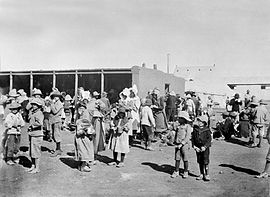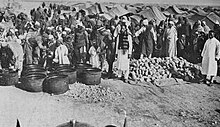Concentration camp
|
Read other articles:

Pour les articles homonymes, voir James. Colin JamesColin JamesBiographieNaissance 17 ao√Ľt 1964 (59 ans)ReginaNationalit√© canadienneActivit√©s Chanteur, guitariste de jazz, musicien de jazz, producteur de disquesP√©riode d'activit√© depuis 1986Autres informationsInstrument GuitareGenre artistique BluesSite web (en) www.colinjames.commodifier - modifier le code - modifier Wikidata Colin James Munn (n√© le 17 ao√Ľt, 1964 √† Regina, Saskatchewan) est un chanteur et guitariste canadien j…

Two-seat military helicopter of the 1940s R-4 / Hoverfly A Sikorsky R-4 in a hover Role HelicopterType of aircraft Manufacturer Sikorsky Aircraft Designer Igor Sikorsky First flight January 14, 1942 Introduction 5 January 1943 Primary users United States Army Air ForcesUnited States Coast Guard Royal Air Force Produced 1942‚Äď1944 Number built 131 Developed from Vought-Sikorsky VS-300 Developed into Sikorsky R-6 In this image taken in 1944, one of Langley Research Center's Sikorsky YR-4B/HN…

–≠—ā–į —Ā—ā–į—ā—Ć—Ź –ł–Ľ–ł —Ä–į–∑–ī–Ķ–Ľ –Ĺ—É–∂–ī–į–Ķ—ā—Ā—Ź –≤ –Ņ–Ķ—Ä–Ķ—Ä–į–Ī–ĺ—ā–ļ–Ķ.–ü–ĺ–∂–į–Ľ—É–Ļ—Ā—ā–į, —É–Ľ—É—á—ą–ł—ā–Ķ —Ā—ā–į—ā—Ć—é –≤ —Ā–ĺ–ĺ—ā–≤–Ķ—ā—Ā—ā–≤–ł–ł —Ā –Ņ—Ä–į–≤–ł–Ľ–į–ľ–ł –Ĺ–į–Ņ–ł—Ā–į–Ĺ–ł—Ź —Ā—ā–į—ā–Ķ–Ļ. –ė—Ā—ā–ĺ—Ä–ł—Ź –≥–ĺ—Ä–ĺ–ī–į –ú–ĺ–Ĺ—Ä–Ķ–į–Ľ—Ć –°–ĺ–ī–Ķ—Ä–∂–į–Ĺ–ł–Ķ 1 –Ě–į –Ī–Ķ—Ä–Ķ–≥–į—Ö —Ä–Ķ–ļ–ł –°–≤. –õ–į–≤—Ä–Ķ–Ĺ—ā–ł—Ź 1.1 –ü–Ķ—Ä–≤—č–Ķ –Ķ–≤—Ä–ĺ–Ņ–Ķ–Ļ—Ü—č 2 –í–ł–Ľ–Ľ—Ć-–ú–į—Ä–ł 2.1 –†–Ķ–Ľ–ł–≥–ł—Ź 2.1.1 –Ė–į–Ĺ–Ĺ–į –ú–į–Ĺ—Ā –ł –ě—ā–Ķ–Ľ—Ć-–Ē—Ć—Ď 2.1.2 –®–ļ–ĺ–Ľ–į –ú–į—Ä–≥–į—Ä–ł—ā—…

Burkinab√© politician Alassane Bala Sakand√© (born 1969[1])is a politician and bank executive from Burkina Faso who served as President of the National Assembly of Burkina Faso[2] after death of Salif Diallo[3] and National President of People's Movement for Progress.[4] He was elected on 8 September 2017 and deposed on 24 January 2022. References ^ Burkina Faso. Parline: the IPU‚Äôs Open Data Platform. ^ The International Directory of Government 2021. Routledge. …

Borough in London, England London borough in United KingdomLondon Borough of SuttonLondon boroughSutton Town Centre and Trinity Church Coat of armsCouncil logoSutton shown within Greater LondonSovereign stateUnited KingdomConstituent countryEnglandRegionLondonCeremonial countyGreater LondonCreated1 April 1965Admin HQSuttonGovernment ‚ÄĘ TypeLondon borough council ‚ÄĘ BodySutton London Borough Council ‚ÄĘ LeadershipLeader & Cabinet (Liberal Democrat) ‚Ä…

Questa voce sull'argomento stagioni delle societ√† calcistiche italiane √® solo un abbozzo. Contribuisci a migliorarla secondo le convenzioni di Wikipedia. Segui i suggerimenti del progetto di riferimento. Voce principale: San Felice Aversa Normanna. San Felice Aversa NormannaStagione 2008-2009Sport calcio Squadra Aversa Normanna Allenatore Renato Cioffi poi Raffaele Sergio Presidente Giovanni Spezzaferri Seconda Divisione9¬ļ posto nel girone C. Maggiori presenzeCampionato: Di Girolamo…

Impero di Persia (dettagli) (dettagli) Impero di Persia - Localizzazione Dati amministrativiNome completoStato Sublime di Persia Nome ufficialeō≥ŔĄō≥ŔĄŔá Ŕāōßō¨ōßōĪŘĆŔá ōßŘĆōĪōßŔÜ Lingue ufficialiPersiano CapitaleTeheran PoliticaForma di StatoMonarchia ShahMohammad Khan Qajar (1794-1797), Fath ŅAli Shah Qajar (1797-1834), Mohammad Shah Qajar (1834-1848), Nasser al-Din Shah Qajar (1848-1896), Mozzafar al-Din Shah Qajar (1896-1907), Mohammad Ali Qajar (1907-1909), Ahmad Qajar (1909-1925) Nascita1…

TemptationIklan surat kabar kontemporerSutradaraCecil B. DeMilleProduserCecil B. DeMilleJesse L. LaskyDitulis olehHector TurnbullCecil B. DeMille(tak disebutkan)Jeanie MacPherson (tak disebutkan)CeritaHector TurnbullPemeranGeraldine FarrarTheodore RobertsSinematograferAlvin WyckoffPenyuntingCecil B. DeMillePerusahaanproduksiJesse Lasky Feature PlaysDistributorParamount PicturesTanggal rilis 30 Desember 1915 (1915-12-30) Durasi60 menitNegaraAmerika SerikatBahasaBisuIntertitel InggrisAnggaran…
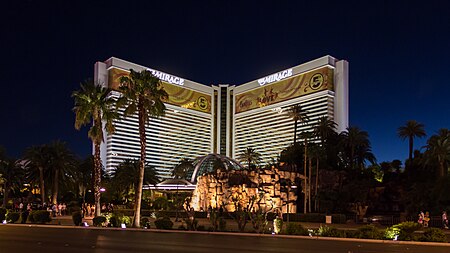
American casino company, precursor to MGM Mirage This article is about the entity formerly known as Golden Nugget Companies. For the current company, see Golden Nugget, Inc. Mirage ResortsFormerlyGolden Nugget Companies (1973‚Äď1989)Company typeDivisionIndustryCasinoFounded1973; 51 years ago (1973)FounderSteve WynnDefunct2000; 24 years ago (2000)FateMerged with MGM Grand, Inc.SuccessorMGM Resorts InternationalHeadquartersLas Vegas, Nevada, U.S.OwnerGolden Nugg…

śú¨Ť°®śėĮŚčēśÖ茹󍰮ԾƜąĖŤ®ĪśįłťĀ†šłćśúÉŚģĆÁĶź„Äāś≠°ŤŅéśā®ŚŹÉŤÄÉŚŹĮťĚ†šĺÜśļźšĺÜśü•śľŹŤ£úÁľļ„Äā śĹõšľŹśĖľšł≠ŤŹĮśįĎŚúčŚú荼暳≠ÁöĄšł≠ŚÖĪťĖďŤęúŚąóŤ°®śĒ∂ťĆĄś†ĻśďöŚÖ¨ťĖčŤ≥áśĖôšĺÜśļźÔľĆśõĺśĹõšľŹśĖľšł≠ŤŹĮśįĎŚúčŚú荼ć„ÄĀŤĘęšł≠ŚúčŚÖĪÁĒĘťĽ®ŤĀ≤Á®ĪśąĖśČŅŤ™ćԾƜąĖŤÄÖťĀ≠šł≠ŤŹĮśįĎŚúčśĒŅŚļúŤ™Ņśü•ŚĮ©Śą§ÔľĆÁāļšł≠ŤŹĮšļļśįĎŚÖĪŚíĆŚúčŚíĆšł≠ŚúčšļļśįĎŤß£śĒ卼ćťÄ≤Ť°ĆťĖďŤęúŤ°ĆÁāļÁöĄšļļÁČ©„ÄāšĽ•šłčŚąóŤ°®šĽ•ÁŹĺšĽäŚŹĮśü•Áü•śôāťĖďÁāļśļĖԾƜ≠£ÁĘļÁöĄťĖďŤęúśīĽŚčēśąĖśī©śľŹś©üŚĮÜśôāťĖĮŤÉĹśó©śĖľśąĖśôöśĖľšĽ•šłčśČÄś≠łť°ěÁ…

The Patria Pasi is a military armoured personnel carrier. It was the choice of the Finnish Defence Forces to replace its aging Soviet BTR-60s. It was a result of the commercial competition between two Finnish companies, a tractor manufacturer Valmet and the lorry manufacturer Sisu, which won the contract with its prototype. Prototypes and series Patria Pasis have been produced in various models for various purposes. Originally Panssari-Sisu, was not produced by Patria, but by Sisu, a lorry manuf…

City in California, United States City in California, United StatesCalabasas, CaliforniaCityCity of Calabasas Clockwise: Aerial view of Calabasas looking northwest; Leonis Adobe; The Commons at Calabasas; Mulholland Highway; The Commons FlagSealLogoLocation of Calabasas in Los Angeles County, CaliforniaCalabasasLocation in Los Angeles metropolitan areaShow map of the Los Angeles metropolitan areaCalabasasLocation in CaliforniaShow map of CaliforniaCalabasasLocation in the United StatesShow map o…

Election for the governorship of the U.S. state of Alaska For related races, see 1974 United States gubernatorial elections. 1974 Alaska gubernatorial election ← 1970 November 5, 1974 1978 → Nominee Jay Hammond Bill Egan Party Republican Democratic Running mate Lowell Thomas Jr. Red Boucher Popular vote 45,840 45,553 Percentage 47.67% 47.37% Results by state house districtHammond: 40‚Äď50% 50‚Äď60%…

Exoskeleton of an animal in the phylum Mollusca Diversity and variability of shells of molluscs on display. Part of a series related toBiomineralization General Mineralized tissues Remineralisation Biocrystallization Biointerface Biofilm Exoskeletons (shells) Arthropod exoskeleton cuticle Brachiopod shell Cephalopod shell cirrate shell cuttlebone gladius Lorica Choanoflagellate lorica Protist shell coccosphere coccolith diatom frustule foraminifera test testate amoebae Seashell echinoderm stereo…
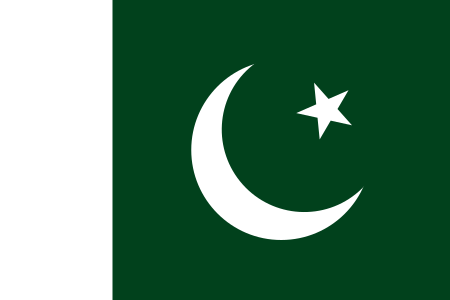
ŔäŔĀō™ŔāōĪ ŔÖō≠ō™ŔąŔČ ŔáōįŔá ōßŔĄŔÖŔāōßŔĄō© ō•ŔĄŔČ ōßŔĄōßō≥ō™ōīŔáōßōĮ ō®ŔÖōĶōßōĮōĪ. ŔĀō∂ŔĄōßŔčōĆ ō≥ōßŔáŔÖ ŔĀŔä ō™ō∑ŔąŔäōĪ ŔáōįŔá ōßŔĄŔÖŔāōßŔĄō© ŔÖŔÜ ōģŔĄōßŔĄ ō•ō∂ōßŔĀō© ŔÖōĶōßōĮōĪ ŔÖŔąōęŔąŔā ō®Ŕáōß. ō£Ŕä ŔÖōĻŔĄŔąŔÖōßō™ ōļŔäōĪ ŔÖŔąōęŔāō© ŔäŔÖŔÉŔÜ ōßŔĄō™ōīŔÉŔäŔÉ ō®Ŕáōß Ŕąō•ō≤ōßŔĄō™Ŕáōß. (ō£ŔÉō™Ŕąō®ōĪ 2023) ŔÖō≠ō®Ŕąō® ōßŔĄō≠Ŕā (ō®ōßŔĄō£ōĪōĮŔąŔäō©: ŔÖō≠ō®Ŕąō® ōßŔĄō≠Ŕā‚Äé)‚ÄŹ ŔÖōĻŔĄŔąŔÖōßō™ ōīōģōĶŔäō© ōßŔĄŔÖŔäŔĄōßōĮ 22 ŔĀō®ōĪōßŔäōĪ 1934(1934-02-22)ŔÉōĪōĮōßō≥ŔĀŔąōĪ [ŔĄōļōßō™ ō£ōģōĪŔČ]…
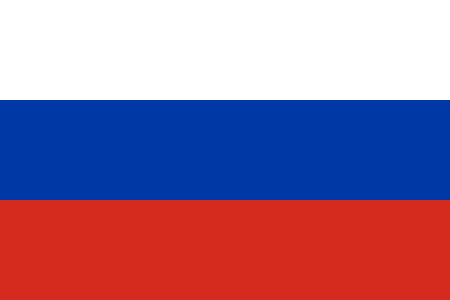
ŔĄŔÖōĻōßŔÜŔć ō£ōģōĪŔČōĆ ō∑ōßŔĄōĻ ō£ōĪŔäōß (ō™Ŕąō∂Ŕäō≠). ō£ōĪŔäōß ōßŔĄō•ō≠ōĮōßōęŔäōßō™ 57¬į29‚Ä≤03‚Ä≥N 45¬į58‚Ä≤13‚Ä≥E / 57.484166666667¬įN 45.970277777778¬įE / 57.484166666667; 45.970277777778 ō™ōßōĪŔäōģ ōßŔĄō™ō£ō≥Ŕäō≥ 1933 ō™Ŕāō≥ŔäŔÖ ō•ōĮōßōĪŔä ōßŔĄō®ŔĄōĮ ōĪŔąō≥Ŕäōß[1] ōĻōĮōĮ ōßŔĄō≥ŔÉōßŔÜ ōĻōĮōĮ ōßŔĄō≥ŔÉōßŔÜ 4014 (1979)[2]5481 (1989)[3]5016 (2002)[4]5043 (2008)[5]5004 (2009)[5]5015…

ō¨Ŕąōßō≤ ōßŔĄō≥ŔĀōĪ ŔáŔą ŔąōęŔäŔāō© ōĪō≥ŔÖŔäō© ō™ōĶōĮōĪŔá ōßŔĄōĮŔąŔĄ ŔĄŔÖŔąōßō∑ŔÜŔäŔáōß Ŕäō≥ŔÖō≠ ŔĄŔĄōīōģōĶ ō®ōßŔĄō≥ŔĀōĪ ō•ŔĄŔČ ōĮŔąŔĄ ō£ōģōĪŔČ. ŔĀŔä ō®ōĻō∂ ōßŔĄō≠ōßŔĄōßō™ōĆ ō™ōĶōĮōĪ ōßŔĄōĮŔąŔĄ Ŕąōęōßō¶Ŕā ō≥ŔĀōĪ ŔÖŔÖōßōęŔĄō© ŔĄō¨Ŕąōßō≤ōßō™ ōßŔĄō≥ŔĀōĪ ŔĄō≥ŔÉōßŔÜŔáōß. ō™ŔāŔąŔÖ ōßŔĄŔÖŔÜōłŔÖōßō™ ōßŔĄōĮŔąŔĄŔäō© ō£Ŕäō∂Ŕčōß ō®ō•ōĶōĮōßōĪ Ŕąōęōßō¶Ŕā ō≥ŔĀōĪ ŔĄŔÖŔąōłŔĀŔäŔáōĆ ŔąōßŔĄō™Ŕä ō™ō≥ŔÖŔČ ōĻōßōĮō©Ŕč ō¨Ŕąōßō≤ ōßŔĄŔÖōĪŔąōĪ. ŔäōĻōĪō∂ Ŕáōįōß ōßŔĄŔÖŔāōßŔĄ ōĶŔąōĪŔčōß ŔĄŔÖōģō™ŔĄŔĀ ō¨Ŕąōßō≤ōßō™ ōßŔĄō≥ŔĀōĪ ōß…

Supercoppa di Polonia 2018Superpuchar Polski 2018 Competizione Supercoppa di Polonia Sport Calcio Edizione 27¬™ Organizzatore PZPN Date 14 luglio 2018 Luogo Polonia Direttore Szymon Marciniak Risultati Vincitore Arka Gdynia(2¬ļ titolo) Secondo Legia Varsavia Statistiche Gol segnati 5 Cronologia della competizione 2017 2019 Manuale La 27¬™ edizione della Supercoppa di Polonia si √® svolta a luglio tra il Legia Varsavia, vincitore del campionato, e l'Arka Gdynia vincitrice della …

John Magufuli Presiden Tanzania ke‚Äď5Masa jabatan5 November 2015 ‚Äď 17 Maret 2021Perdana MenteriKassim MajaliwaWakil PresidenSamia SuluhuPendahuluJakaya KikwetePenggantiSamia Suluhu Informasi pribadiLahirJohn Pombe Magufuli(1959-10-29)29 Oktober 1959Chato, TanzaniaMeninggal17 Maret 2021(2021-03-17) (umur 61)Dar es Salaam, TanzaniaPartai politikChama Cha MapinduziSuami/istriJaneth MagufuliAnak2Alma materUniversitas Dar es SalaamSunting kotak info ‚ÄĘ L ‚ÄĘ B John Pom…

Rebel advances 2014 Idlib offensivePart of the Syrian Civil WarMap of frontlines following the offensive. Territorial changes as a result of the offensive can be seen south of Maarrat al-Nu'man/north of Morek.Date5 March ‚Äď 25 May 2014(2 months, 2 weeks and 6 days)LocationIdlib Governorate SyriaResult Rebel victory Rebels lift the Army siege of Khan Shaykhun and secure the city and its surroundings Rebels cut two supply lines to Army bases in Idlib governorate Rebels capture two …
